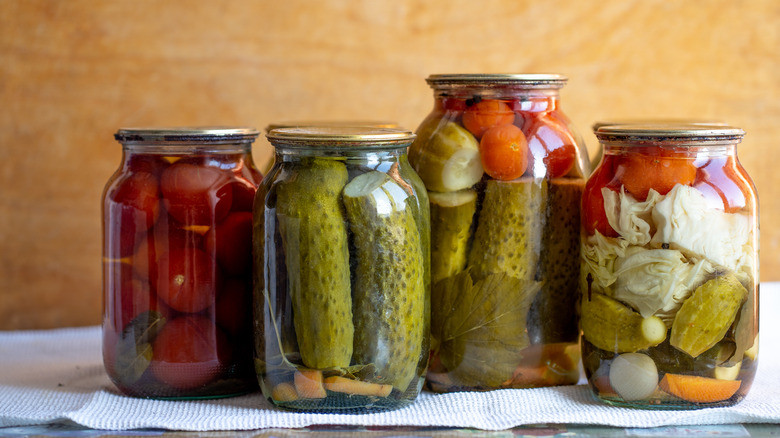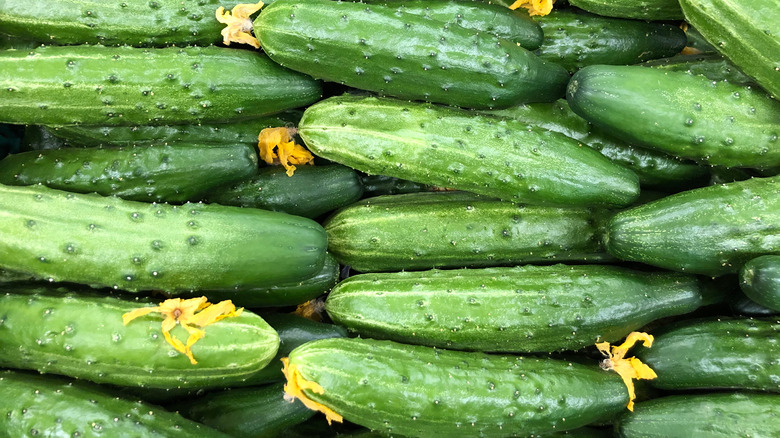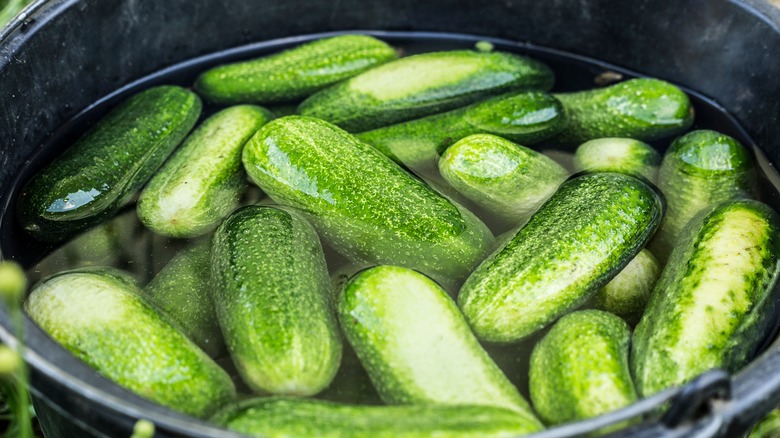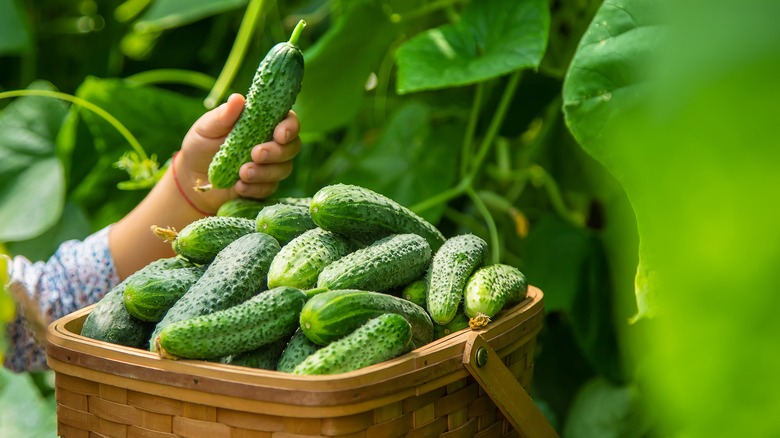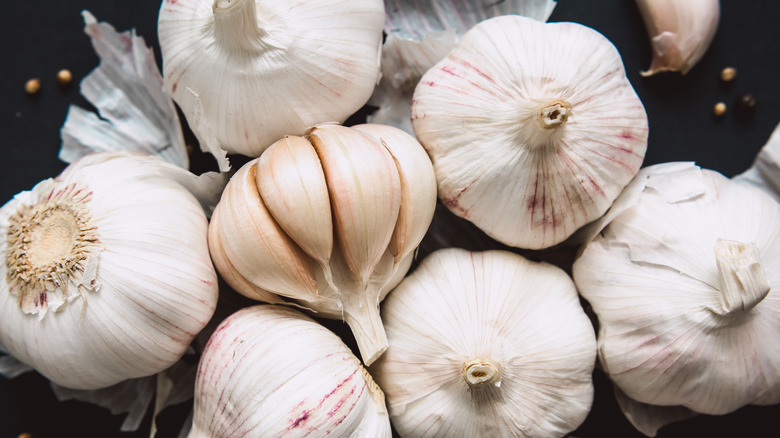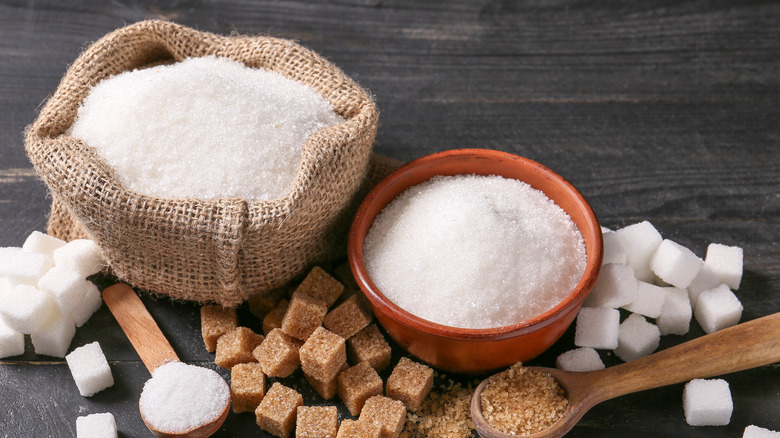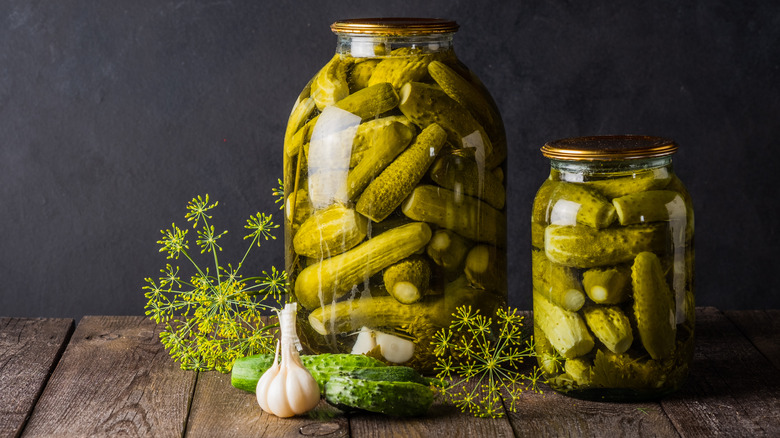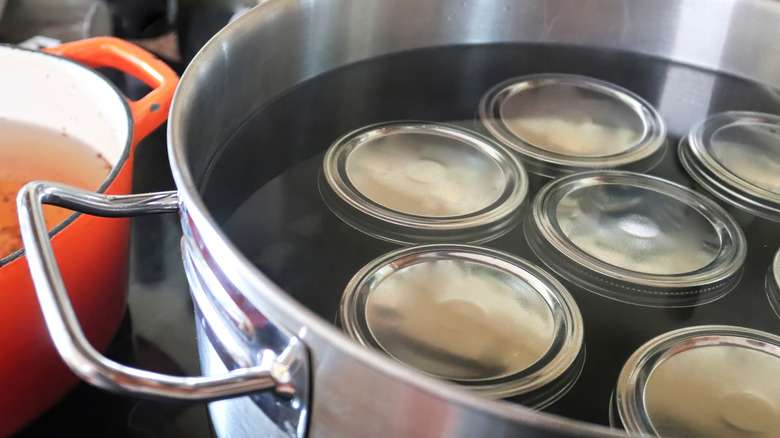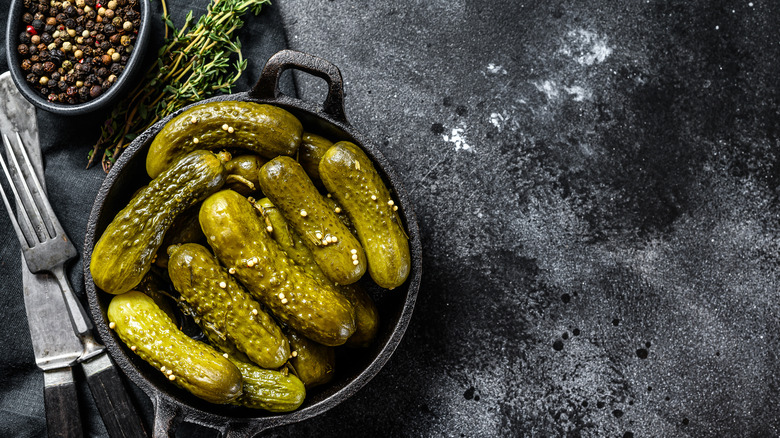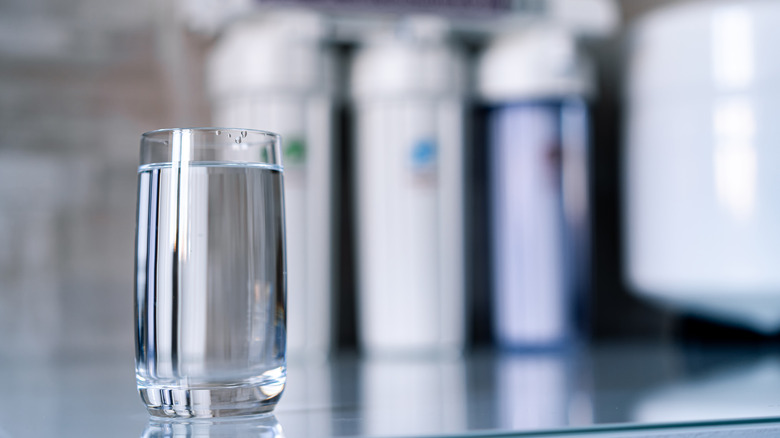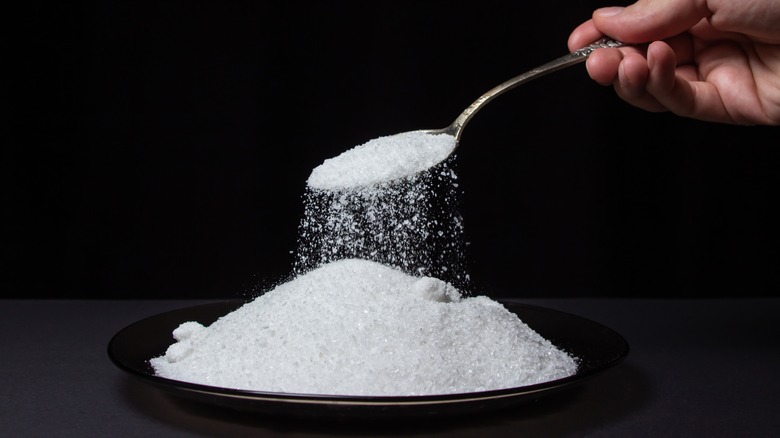Tips You Need When Making Homemade Canned Pickles
Is there any better accompaniment to a delicious sandwich than a fresh, ripe pickle? Whether you prefer stringently sour pickles or slightly sweet bread-and-butter pickles, pickles make an excellent side dish for a countless number of meals, and can also be eaten as a tasty snack on their own.
There are, without a debt, plenty of great commercial pickle brands on the market today — including a number of niche and artisan pickle makers. But making pickles on your own at home is not especially difficult, and can be particularly rewarding. For those new to the pickling process, making homemade pickles might seem a little daunting. But to get started, you don't really need any fancy equipment or particularly exotic ingredients. In practice, by approaching the task carefully — and following the tips listed below — you might quickly find that you can conveniently make delicious pickles right in your home kitchen. How convenient!
Choose freshly picked, high-quality cucumbers
Firm, recently gathered cucumbers are the ideal fruit you want to use when you are making your own pickles. Fresh cucumbers are less likely to be hollow and are more likely to be firm and hold their shape well through the pickling process (via the University of Minnesota Extension). If you're fortunate enough to have some growing space at home — great! Using recently harvested cucumbers, picked at their prime, is in some respects the ideal (and most traditional) way to go. But if not, there are other ways to find fresh options that will make for great pickles.
Take a look at what's available at your local grocery store or co-op, picking carefully for freshness and superior quality. If you have a farmers' market nearby, that can also be a great place to shop for fresh produce. Starting out with the best fruit will serve you well in the long run, and will help your cucumbers hold up well to the pickling process.
Soak your cucumbers in pickling lime and water before processing
Sometimes even very fresh cucumbers might need a little something "extra" to be sure they hold up well through the pickling process. One option is using pickling lime, which can really bring out their crispiness. Pickling lime (also known as food-grade calcium hydroxide, notes Healthline) works by binding to pectin and helps to firm up cucumbers prior to pickling. According to the Oregon State Extension, with fresh cucumber pickling, lime might not be necessary — and pre-soaking cucumbers in ice water is an alternative to using lime.
But if you do use it, a soak of up to 24 hours can help pickles stay firmer throughout the process. It is important to carefully follow any instructions, as well as to rinse the cucumbers and soak them in fresh water after the pickling lime soak, to be sure you remove all the pickling lime.
Avoid using cucumbers that are too large
Cucumbers are a productive crop, and the fruit can frequently get quite large. While the extra-large fruits can be impressive, save the biggest ones for soups, salads, and other dishes — and avoid using them for pickling. According to the University of Minnesota Extension, large-diameter cucumbers (over 2 inches) can be problematic for the pickling process.
The vinegar and pickling solution will sometimes be unable to effectively penetrate a fruit diameter that size, and you will be left with only partially pickled, and perhaps not fully preserved, cucumbers. At the same time, pickles that are too big can be more likely to shrivel during the process. Try to select smaller cucumbers for pickling — or if you cannot find smaller ones, slice the large ones into little pieces. If the cucumber's diameter is too big, you may end up ruining your batch of homemade pickles.
Include fresh spices in your recipe
A diversity of spices is essential to a good pickle and will play an outsized role in determining the ultimate taste. Whether you are making something relatively standard — like a more or less run-of-the-mill but tasty dill pickle recipe with dill, sliced garlic, and pickling spices — or something more unusual or complex with extra exotic flavors, using fresh spices is extremely important. As the National Center for Home Food Preservation points out, old or expired spices can actually have seriously detrimental effects on how the pickling process turns out, beyond simply imparting underwhelming flavor.
Ingredients that are too old can sometimes produce soft or even spoiled pickles. Don't risk losing a whole batch of pickled food just because the spices were not right. Using fresh garlic and other spices will help you avoid seriously problematic problems (like mold), while substantially boosting the pickles' flavor.
Use white or brown sugar
Some type of sweetener is common in most pickle brines — and not just for more classic "sweet" pickle recipes, like bread and butter pickles. Sugar is important because it offsets the vinegar, preventing pickles from becoming too sour (via the University of California Agriculture and Natural Resources). Of course, though, you can choose to make your pickles extra sour, so long as you keep the vinegar at the level outlined in the recipe. Assuming you are using sweeteners, though, it's important to remember that when it comes to pickling, all sweeteners are not created equal.
White and brown sugar are the ideal sweeteners to use in your pickling recipe, says Oregon State Extension. If you do use brown sugar, know that it will make the brine darker. But above all, avoid other sweeteners like honey or corn syrup. These don't work well and can give your pickles a strange taste.
Follow a reliable recipe
You might be tempted to "wing it" when you are making homemade pickles. After all, you're just marinating vegetables in some vinegar-based brine, right? Not quite. In truth, there really is an art — and a carefully measured science — to pickling. As North Dakota State University points out, pickling — while an almost ancient method of preserving food — requires some delicate calibration to work properly. Having the correct acidity in your pickle is vital to making the finished product you are creating taste great, but it is also integral to the safety of the preservation process.
Using the correct vinegar-to-water ratio, and using vinegar with sufficient acidity, is essential to avoiding food-borne illness or other problems that can arise with the preservation process. Fortunately, there are plenty of great, thoroughly tested pickling recipes out there, whether you want to make pickle chips, spicy Giardiniere pickles, or something else entirely.
For long-term storage, process in a water bath
If you're first getting into pickling, it's important to distinguish between two types of pickling — particularly "quick pickling" versus traditional, water bath-canned pickling. The former, according to The Washington Post, basically refers to covering vegetables and spices with brine and sticking them in the refrigerator. Quick pickling is fast, easy to learn, and pretty safe, particularly from botulism (the acidity and refrigeration are not conducive to the dangerous bacterium). This said, if you want to make pickles the traditional way, and keep them shelf-stable for longer (without refrigerating them) processing in a water bath is essential. If you are following a tested recipe for home canning, it should contain directions for water bath processing.
But the process is pretty standard. Colorado State University Extension notes it involves packing your pickles, spices, and brine into sterilized jars, releasing the air bubbles in the jar, sealing the jar, and then placing the jars in boiling water for the time required — which varies depending on the jar size and on altitude.
Cover sufficiently in brine
There are a number of different types of vinegar you can use when pickling. The key is acidity. According to PennState Extension, you want at least 5% acidity in the vinegar you select for your pickling recipe. Too little acidity and you may spoil whatever you're pickling; too strong acidity and the taste may well be off. While some recipes do advertise using flavored or exotic vinegar, distilled white vinegar and apple cider vinegar are often the default choices for pickling recipes, due in part to their milder flavor. Just be sure the acidity level is right with the brand you purchase!
White vinegar is a good choice for another reason: It tends to be inexpensive. This is helpful because when pickling, you cannot skimp on vinegar. It is vital that cucumbers are fully covered in brine, says the National Center for Home Food Preservation, in order to properly complete the pickling process and avoid spoiled or soft pickles.
Use soft water
Did you know that the type of water you use for pickling can be a factor in how they turn out? To be sure your water quality is appropriate for pickling, it's important to review the difference between hard and soft water. According to the United States Geological Survey, the "hardness" of water refers to the amount of dissolved calcium and magnesium (and potentially other minerals) in water. Depending on where you live and the source of your home's water, your water may be harder or softer. In practical terms, harder water often means you will often see spots or other blemishes on cleaned dishes and glassware. Despite being potentially unattractive, hard water definitely isn't itself bad — and can be a good source of minerals.
When it comes to pickling, though, hard water can actually be a problem (via Michigan State University Extension). Hard water can discolor pickles, clouding the brine solution that you use for pickling. Primarily for that reason, using soft water is ideal. If you don't have access to soft water, don't worry — you can make your own. Boil your hard water, let it sit for about 24 hours, and then remove the scum that's sitting on top. Afterward, carefully and slowly pour the water out into another vessel, without disturbing the sediment that has settled to the bottom of the boiled hard water. The new water is ready to use! If that sounds too labor-intensive, buying distilled water is also a good option.
Store jars away from direct sunlight
You might think that after carefully following a recipe, measuring and making a proper brine, jarring your pickles, and processing jars in a water bath, you are all set with the process. Actually, in some ways, this is just when the process gets started. The pickling process takes some time to work properly, and how you store your pickles in progress is actually essential for their ultimate flavor.
With that in mind, it is important to let them pickle in a cool, dark place. Via Clemson Cooperative Extension, avoiding excessive exposure to sunlight is very important when making pickles. In other words, don't let them sit on the windowsill. Pickles that have significant exposure to light may get a spotted or faded color, making them less appealing and potentially disrupting the entire process. A dark location with a stable and cool temperature is your best bet to be sure those pickles turn out great.
If something looks wrong, throw it away
There are times when you follow a recipe carefully, measure out every ingredient, and review each step of the process closely — only to find that at the end, something is off. Maybe the pickles have a weird color that stands out to you. Maybe you see some scum in the jar. Or maybe something just smells a little bit funny. Whatever the result, when preparing food at home, it's essential to trust your senses. As the State of Idaho reminds (in an advisory to home food preparers), "When in doubt, throw it out!"
Canning — and particularly pickling — can be quite safe, provided you carefully follow a tested recipe and don't skip steps. But things can always go wrong. While the biggest risk in home canning (botulism) is less of a risk in carefully pickled recipes, due to the vinegar's acidity, Clemson Cooperative Extension says, problems can develop. Choosing the wrong vinegar, failing to properly clean jars, and other factors can sometimes be overlooked in a busy canning process. In short: If you see mold, if you smell something that doesn't seem right, or if something just seems "off" to you, don't eat it.
Pick the right type of salt
If you're an experienced chef or baker, you're probably familiar with the wide variety of salts on the market. From pink Himalayan salt to black Hawaiian salt to plain old iodized salt, there's quite a variety to choose from. While many of these salts can have their place in home cooking recipes, when it comes to pickling, your best bet is to choose canning and pickling salt. As described by Oklahoma State University Extension, canning and pickling salt, which is free from additives, is ideal for the pickling process. Typical table salt contains an anti-caking agent (calcium silicate) that can make pickled jars cloudy and possibly contribute to spoilage, while added iodine can potentially discolor pickles.
Kosher salt and sea salt don't typically have additives, but the larger size can make precise measurement more difficult; sea salt can also be potentially problematic, as it may have other minerals present. If you absolutely cannot find canning and pickling salt, substituting kosher salt — but doing so by weight — is the recommended replacement.
Experiment with other vegetables
When someone says "pickles," cucumbers are typically the vegetable that comes to mind. Whether spears, whole cucumbers, gherkins, or bread and butter chips, cucumbers are a versatile fruit that allow for many methods of pickled preservation. That said, cucumbers are hardly the only fruit or vegetable that can be pickled. While they may be a great place to start if you're a novice, if you already have some pickling experience — or if you just want to reach for something more unusual — try something else.
There are countless options for pickling. Trying out different foods, as well as alternative spices and vinegar (so long as you maintain the correct acidity level), can help you expand your canning abilities. Onions, radishes, and jalapeños are only a few of the many options that can make a great pickle. Also keep in mind that pickles are sometimes integral to diverse cuisines, serving as integral components in broader patterns of flavor. Mexican-style pickled carrots can be a great addition if you're making a Mexican or Southwestern dish, for instance, while pickled red onion can make a delicious topping to a Brussels sprout-based dish.
